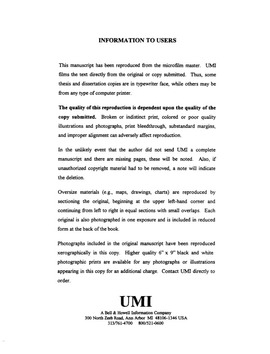| dc.contributor.advisor | Lomolino, Mark V., | en_US |
| dc.contributor.author | Perault, David R. | en_US |
| dc.date.accessioned | 2013-08-16T12:30:08Z | |
| dc.date.available | 2013-08-16T12:30:08Z | |
| dc.date.issued | 1998 | en_US |
| dc.identifier.uri | https://hdl.handle.net/11244/5677 | |
| dc.description.abstract | Characterizing the influence of landscape features on assessments of isolation is critical to understanding dispersal, and, ultimately, the structure of native communities in fragmented ecosystems. At the same time, a comprehensive understanding of such landscape features, especially corridors, requires assessing corridors individually and incorporating the habitat needs of relevant species. By considering biologic responses to fragmentation at appropriate scales, we can work to maintain natural processes and preserve natural levels of biodiversity. | en_US |
| dc.description.abstract | Ecological landscapes are often viewed as heterogeneous mosaics of suitable habitat interspersed within a suboptimal matrix. Fragmentation of such landscapes has altered the natural patterns of these mosaics. As a result, processes such as immigration have also been altered, with dire consequences on biodiversity. I assessed how anthropogenic influences on the Olympic National Forest, Washington, have affected landscape measures of isolation and resulting species diversity. I assessed alternative indices of isolation for sites located in three types of old-growth forest: fragments, corridors, and continuous forest. These isolation indices vary in how they identify sources of colonizers and in their characterization of the landscape matrix. I compared levels of variance and redundancy among these measures to ascertain the most relevant index for assessing isolation. I then focused on the role of corridors in ameliorating the effects of fragmentation by decreasing isolation. To assess such corridor utility, I quantified among-and within-corridor variability in community structure, landscape indices, and habitat descriptors. | en_US |
| dc.description.abstract | Although highly correlated, optimal measures of isolation varied among types of sites. The influence of corridors on species responses to isolation was shown to be very strong. While variability in species assemblages and habitat was very high among the four corridors studied, such variability was low along individual corridors. This suggests that although these corridors appeared to be effective through their entirety, possibly acting as demographic sources of individuals, they should not be considered equivalent to one another. | en_US |
| dc.format.extent | xv, 240 leaves : | en_US |
| dc.subject | Landscape ecology. | en_US |
| dc.subject | Corridors (Ecology) | en_US |
| dc.subject | Environmental Sciences. | en_US |
| dc.subject | Agriculture, Forestry and Wildlife. | en_US |
| dc.subject | Biology, Ecology. | en_US |
| dc.subject | Mammal populations. | en_US |
| dc.title | Landscape heterogeneity and the role of corridors in determining the spatial structure of insular mammal populations. | en_US |
| dc.type | Thesis | en_US |
| dc.thesis.degree | Ph.D. | en_US |
| dc.thesis.degreeDiscipline | Department of Biology | en_US |
| dc.note | Adviser: Mark V. Lomolino. | en_US |
| dc.note | Source: Dissertation Abstracts International, Volume: 59-07, Section: B, page: 3198. | en_US |
| ou.identifier | (UMI)AAI9839811 | en_US |
| ou.group | College of Arts and Sciences::Department of Biology | |
